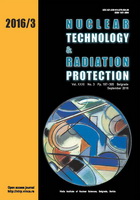
RADON EXHALATION RATES FROM COMMON BUILDING MATERIALS IN INDIA
Effect of Back Diffusion

Vol.
XXXI, No. 3, Pp. 197-305
September 2016
UDC 621.039+614.876:504.06
ISSN 1451-3994
Pages: 277-281
Authors: Amit Kumar and Rishi Pal ChauhanAbstract
A radon exhalation study for building materials was carried out by closed accumulator technique using plastic track detector LR-115 type-II, taking into account the effect of back diffusin. The back diffusion of radon into the materials causes an underestimate of free exhalation rates. The results showed that radon exhalation rates of soil, sand, brick powder, and crasher were found to be high as compared to rice husk ash, wall putty, and plaster of Paris. The radon exhalation rates from building materials varied from 0.45 ± 0.07 mBq/kgh to 1.55 ± 0.2 mBq/kgh and 3.4±0.7 mBq/m2h to 28.6 ± 3.8 mBq/m2h as measured without considering back diffusion. The radon exhalation rates of building materials oblivious of back diffusion varied from 4.3 ± 0.8 mBq/m2h to 44.1 ± 5.9 mBq/m2h. The radon exhalation rates from building materials can be used for estimation of radon wall flux and indoor radon concentration. Thus, it is necessary to make correction in the measured exhalation rates by back diffusion.
Key words: radon exhalation, back diffusion, accumulator technique
FULL PAPER IN PDF FORMAT (344 KB)